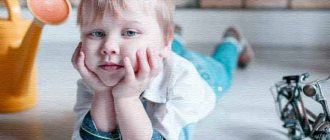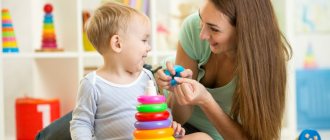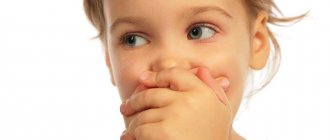Factors influencing speech development
At what month will the baby speak depends on many factors, including:
- Genetic predisposition. If the mother or father spoke relatively late, then it is likely that the child will begin to speak with some delay. This factor is directly related to the characteristics of the articulatory apparatus - it can develop both quickly and relatively slowly.
- Gender of the baby. As a rule, girls pronounce their first words earlier than boys and by the age of two have a richer vocabulary. This is due to the fact that they generally develop faster, and their nervous system is more plastic.
- Quality of the language environment. Scientists have discovered that the baby remembers his first words even when he is in the mother’s womb. The more often a child hears human speech, the faster he masters it. When parents communicate little with each other, and do not talk to the child, but only lisp, then it is not surprising if he begins to speak late, and his vocabulary turns out to be extremely poor.
- Individual developmental characteristics. Much depends on the baby’s innate temperament. Introverted children can be silent, although they understand the speech of others quite well. Whereas little extroverts begin to show speech activity relatively early.
Passive and active vocabulary
During this period, attention is drawn to such a characteristic feature as imitation of the words of adults. The baby repeats not only familiar words, but also previously unknown ones. These could be words addressed to the child, or words that he heard from others. Such active imitation can be noticed already from 1 year 5 months. Here it is important not to coo with children, faking your speech in “childish” language, but to give an example of the correct pronunciation of words.
Starting from the first year of life, the understanding of words grows; the baby is familiar with the names of objects in his immediate environment, the names of objects, animals and other objects that are most often shown to him in pictures in children's books, on the street. The baby loves to look at bright colored book illustrations. Adults should maintain this interest by choosing clear pictures.
When commenting on illustrations to a child, you need to speak precisely, in simple words, try to denote the object with one, constant word, so that the meaning of the picture is not lost in the stream of speech of an adult. For example, while the word monkey is used to describe monkeys and gorilla.
By the age of one and a half years, a child’s active vocabulary is 20–30 words; its sound composition is still simple. Thanks to the desire to imitate the speech of adults, by the end of the second year the baby increases the number of spoken words tenfold. Speech is dominated by nouns, but there are also verbs (2-3 times less of them) and adverbs (there, here, here).
Occasionally, by the age of two, the use of adjectives can be found in children's speech; this feature will continue to persist into early preschool age. Personal pronouns are often found in a child’s speech and are easily used (I, you, he, she).
Speech development norms from one to two years
A one-year-old baby already responds to his name, understands when he is told “no,” and actively imitates the speech of adults. He responds to requests: “sit down”, “stand up”, “take it”. He waves his hand back when he is told “bye-bye.” But his vocabulary is still small and includes only a few words (about 10), consisting of one or two open syllables: “mama,” “dad,” “baba,” “give,” “bi-bi.”
After a year and a half, the child’s vocabulary already reaches 50-60 words - and then phrasal speech begins to form. The first phrases consist of only two words. For example, pointing to his favorite car, the baby says: “Mom, beep.”
At approximately 16-18 months, the so-called “lexical explosion” occurs, when passive vocabulary becomes active. That is, the baby begins to actively introduce into his vocabulary all the words that he has previously memorized.
By the end of the second year of life, children already pronounce from 100 to 300 words and use prepositions in conversation. But the speech of a two-year-old child may not be entirely understandable to adults, since he does not retain the syllabic structure of words - he pronounces many sounds incorrectly or skips them completely. Especially if the word is difficult to pronounce and has closed syllables. But children of this age actively supplement their speech with gestures and facial expressions - this makes it more understandable for adults.
Basic Physical Skills
At one year of age, the child sits and stands confidently with the support of an adult or while holding onto an object or wall, and crawls. The baby can easily get to his feet from a sitting position, and it is not at all necessary that he crawl before his first steps - some children bypass this stage. Active children are usually in a hurry to start walking as quickly as possible: they prefer to hold on to support on their own or, whenever possible, to the hand of an adult in order to reach the intended goal. Incredible, but true: in just 12 months, the child moves from an absolutely horizontal position to a vertical and very mobile one.
What should a 1 year old child be able to do:
- move along the steps of the stairs, holding the hand of an adult, crawl along the steps;
- independently climb onto a chair, armchair, sofa and other surfaces;
- climb down a ladder or piece of furniture.
Parents of the baby need to take all these features into account. After all, if you do not protect your baby from dangers in time (windows that do not have protective nets, open sockets, hot, sharp and heavy objects on the edge of the table, etc.), then you may encounter tragic situations. Do not hope that a one-year-old child is not able to quickly find himself on a windowsill or table: he is very smart and confidently strives for his goal.
Of course, this does not mean that the child should always be told “no” and any of his movements should be limited. Just the opposite: trusting the baby, but constantly looking after him, try to show him that there are objects of great danger in the world around him, be sure to indicate them with a certain code word and gesture. And if you want your baby to take his first steps as quickly as possible, pick him up less often and encourage him to move independently. For example, give him the opportunity to climb a slide or step over the sandbox curb. Be a “safety element”, but do not do his “work” for the child.
Symptoms of speech delay
The sooner parents discover that something is wrong with their child’s speech, the easier it will be to correct the situation and avoid serious consequences. Here are the signs that should alert you:
- per year: the child behaves strangely quietly, does not try to pronounce syllables, and the sounds he makes do not really resemble an attempt to speak;
- at one and a half years: the baby does not say a single simple word (“mom”, “dad”, “bi-bi”), but at best makes sounds, does not react when called by name, does not pay attention to requests;
- at two years old: the child does not speak at all or speaks very unintelligibly, and his vocabulary is limited to a few simple words.
Open lesson on speech development in the senior group according to the Federal State Educational Standards
Mom's School: what a 1-year-old child should be able to do
Psychoneurologist Krasnova Marina Aleksandrovna advises the CMN doctor: What should a baby be able to do at 1 year old? Walking child. Lexicon. Skills and abilities, etc.
Development program for 1 year. First birthday. Skills and abilities of a one-year-old baby, features of a child’s walking. Formation of active speech, vocabulary, passive vocabulary, understanding of instructions. Basic skills at 1 year: potty training, mug training, spoon training, neatness. When should a parent be wary? Indications for contacting a neurologist. What disorders are most often missed at this age? Signs of speech delay, psycho-speech development, sensorineural hearing loss. How to avoid missing autism? Who should you show yourself to if you walk on your toes? Specialists examining a child at 1 year of age. Conclusion of the commission in 1 year.
Skills by month:
1 month | 2 month | 3 month | 4 month | 5 month | 6 month | 7 month | 8 month | 9 month | 10 month | 11 month
Do you want to be the first to read our materials? Subscribe to our telegram channel, Facebook page, or VKontakte group.
We are at Yandex.Zen - join us!
Possible causes of the problem
Speech development in a baby may be slowed down for the following reasons:
- Mental disorders. They can range from minimal brain dysfunction to severe dementia.
- Hearing loss (acquired and congenital). The degree of hearing loss varies, and the stronger it is, the worse the situation with speech.
- Social factors. If parents do not care about the speech development of their child, he will speak poorly, even if he is completely healthy.
- Pathologies of the development of the articulatory apparatus. Any disruption of the functioning of the organs responsible for the reproduction of sounds is fraught with speech delay or even complete muteness.
The saddest thing is that, regardless of the cause of a child’s speech delay, it always entails a slowdown in mental development. And the longer parents ignore the problem, the higher the likelihood that the child will become mentally disabled.
Diagnosis of speech delay
A baby who is lagging behind in speech development should be shown to specialists, including a pediatrician, speech therapist, psychologist, psychiatrist, neurologist and otolaryngologist. To detect the cause of violations, the following diagnostic procedures are carried out:
Hearing test
A pediatric otolaryngologist will be able to determine whether the baby hears well. Examination and special tests not only give an idea of the extent of damage to the organs responsible for hearing, but also identify the cause of the problem (rupture of the eardrum, chronic otitis media, pathologies of the structure of the inner ear, etc.).
Parents can check their baby’s hearing on their own, at home. To do this, you need to move away from him at a distance of about 6 meters and clap your hands. Normally, the child should immediately turn his head towards the sound. If he does not react, you should come closer a couple of meters and repeat the clap. Lack of response will almost certainly indicate hearing problems.
Diagnostics of fine and gross motor skills
By observing a child’s motor activity and how he handles toys, an experienced neurologist will be able to tell how much his psychomotor development corresponds to the age norm. Special tests are also used (Denver test, Griffiths scale, etc.).
You can understand whether a child has problems with fine and gross motor skills at home. To do this, parents need to watch him for some time. Gross motor skills are developed normally if the baby:
- can back away;
- steps over small objects;
- pushes a ball with his foot;
- jumps up.
We can talk about normal development of fine motor skills if the child:
- easily places cubes on top of each other (builds a house);
- tries to catch a ball that was thrown to him;
- takes small objects with two fingers (developed “tweezers grip”);
- can break a large piece of plasticine into small pieces;
- easily places the rings of the children's pyramid onto the stand pin.
If motor skills are impaired, the baby's movements are imprecise and poorly coordinated.
Diagnostics of articulation organs
The speech therapist examines the child and assesses whether the structure of the tongue, lips, teeth, jaw and palate corresponds to the norm, and whether there are any developmental anomalies that interfere with speaking. Among such violations visible to the naked eye:
- malocclusion (when the teeth do not fit together);
- a short frenulum of the tongue, which prevents you from lifting it up;
- a very thick or, conversely, small tongue;
- narrow and high palate (the so-called “Gothic”);
Testing speech understanding
How well a child responds to words for his age can be determined by a child psychologist. But parents can also conduct a small test by asking the child:
- show different parts of the body (legs, arms, head, tummy);
- put toys in boxes;
- jump and clap your hands;
- bring any familiar thing (slippers, book, etc.).
How a baby discovers the world
Now your baby is actively interested in the “details of the world,” which begins with his own toys. He may strive to assemble and disassemble something, and watch how adults do it.
“Manual skills”, what a child should be able to do at 1 year:
- “work” with a pyramid consisting of several rings: disassemble it and assemble it;
- build a house by placing a couple of cubes on top of each other;
- is interested in the design of objects with lids - boxes, saucepans; can put other objects in them and cover them with lids;
- is interested in sorter toys, into the holes of which you can push an object; you can make such a homemade “sorter” from an ordinary box by cutting a round or rectangular hole in it;
- if you put an empty plate and cup in front of him, he can “drink” or “eat” from it, “like a toy,” showing that he knows how to do this;
- can take a toy as it is convenient for him - with one or two hands, and with two fingers, transfer it from one hand to another;
- understands that objects can move (car, ball, stroller, etc.) and therefore strives to roll them;
- plays with the doll: feeds it, puts it in the crib, combs its hair, etc.;
- plays with his things - slippers, hat, etc.;
- can use the closet independently: open and close a drawer or door, take out toys or things and put them in the closet;
- tries to repeat what other children or adults do: clap their hands, knock on an object, dig sand with a shovel, etc.;
- copies the actions of adults: wipes the dust like mom or fixes the faucet like dad.
Prevention of speech delay
If the examination shows that the child’s speech problems are not caused by illness, but by the fact that parents do not pay enough attention to the development of his speech abilities, it is necessary to urgently take preventive measures to prevent further lag. Here are some tips to remedy the situation:
- Spend time talking to your baby every day. Speech training should be daily.
- When talking with your child, avoid lisping and deliberately distorting sounds. In order for him to form correct speech, replace the abbreviated words “lala”, “woof-woof”, “bi-bi”, “bye-bye” with regular ones.
- Don't scold him for speech errors so that he doesn't become afraid to talk to you, but correct them tactfully and carefully.
- Read fairy tales to your child as often as possible, and then patiently and thoroughly answer all the questions he asks.
- Show interest in everything your child says, do not brush off his attempts to talk to you, even if you are tired or not in the mood.
- Don’t try to predict and fulfill his every desire - let him learn to turn to you with requests.
- Periodically ask him different questions or make small requests. For example, he will look out the window and tell you what the weather is like outside.
Games for the development of coherent speech in the middle group - conducting educational activities
When a child begins to speak, the norms
Speech development begins from birth. A newborn screams to attract attention. By the age of 2 months, he begins to respond to the voices of loved ones and respond to them with humming. At six months, sounds acquire an emotional coloring, intonation appears, and the mother can easily recognize from the sound what the baby needs at that moment. If something hurts, his crying takes on plaintive, offended notes, etc. At 7 months, the baby knows his name, pronounces simple syllables, learns to double them: “ma-ma,” “pa-pa.”
By 11 months, he consciously says “mom,” “baba,” and “dad,” and tries to repeat some words heard from his parents. He pronounces several simple words a year, usually with the same syllables.
You can learn more about speech development by month of a child’s life from the table below:
| Age | Speech skills |
| newborn | Scream. Based on its character, experts can immediately predict the success of speech development |
| 1 month | Stops crying when he hears a sharp sound. The scream becomes expressive |
| 2 months | Communicates with adults through a smile. Harbingers of future speech appear: guttural sounds - “mmmm”, “yyyy” |
| 3 months | In response to communication, a complex of revival appears: movement of arms, legs, loud abrupt sounds |
| 4 months | He walks for a long time, listens to his voice. Sings chains of vowel sounds: “aaaa”, “oooo”. Knows his mother's voice, smiles back at her |
| 5 months | Distinguishes the intonation of speech addressed to him. Turns his head towards the sound. |
| 6 months | Babbling appears. The consonants “m” and “b” are added to the vowel chains |
| 7 months | Imitates the intonation and rhythm of adults. Clearly pronounces the syllables “ma”, “ba”, “da”. He is wary of strangers. Reacts to his name |
| 8 months | Uses babbling to attract attention. Knows the meaning of many words, names of toys |
| 9 months | Follows simple verbal instructions. Tries to communicate with adults using speech sounds |
| 10 months | Plays learned games: “okay”. Understands the meaning of the words “no” and “yes” |
| 11 months | Shows body parts. Follows verbal instructions: moves the car, puts the doll to sleep. Expresses desires with speech: give, na |
| 12 months | Speaks his own language with toys. Has an average of 5-6 words in the dictionary |
Each child develops individually, but this table can serve as a guide to identify possible disorders.
What time do children start speaking if the first words are delayed?
1 year is the age when children begin to speak their first words. It is worth noting that speech acquisition can vary greatly: some speak meaningfully at one year of age, while others express their thoughts closer to 2 years. Most girls speak earlier and better than boys.
If by 12 months the child does not say more than one word, does not respond to music, or is unable to fulfill basic requests, it is necessary to consult a doctor. Specialists will check your hearing and vision. If not only speech but also motor development is delayed, a consultation with a neurologist is required.
How to stimulate speech development
If the baby is silent and not very willing to make contact, or if he has difficulty mastering speech, special methods will help to increase his speech activity.
Educational games
A child from one to two years old will learn to speak faster if learning takes place in an unobtrusive, playful way. There are several types of such games:
- Role-playing. During the game, the child plays some role, for example, pretending to be a detective, if it is a game “Find a toy”. You can hide the doll from him, and he will look for it. Or, on the contrary, he hides, and you look for it. During such games, words will constantly be exchanged between you and your baby. There are also plenty of other role-playing games that can involve toys. For example, “Reception of guests”: a bear and a bunny come to visit your baby, and he must treat them to tea. Or the game “Treating a doll”: the doll has a sore throat, she needs to be warmly dressed and given medicine. You can come up with simple plots for such games yourself.
- Games with constructors. Children's construction toys perfectly develop a child's fine motor skills. Scientists have proven that one area of the brain is responsible for speech abilities and finger movements.
- Drawing. There are special coloring books for children from one to two years old. By drawing, the baby trains fine and gross motor skills. He can also tell you about what is shown in the picture - in this way not only his speech will develop, but also his imaginative thinking.
Developmental exercises
Training the articulatory organs prevents speech problems and promotes clearer and clearer pronunciation of words. Recommended exercises:
- Poems. In children's stores you can buy special books with poems for children under two years old. The parent reads the text, and the child repeats it with pleasure.
- Boutier. When a baby blows into a tube, blows soap bubbles, or simply puffs out his cheeks, his organs responsible for producing sounds are trained.
- Tongue movements. The child opens his mouth and moves his tongue left and right, pretending to be a watch, sticks his tongue out as much as possible, and then hides it again. Children are happy to repeat such simple exercises after their parents.
Only a speech therapist can determine how well a child speaks. Therefore, parents must periodically show their children to this specialist. This will allow you to notice and correct any speech problems in time.
Physical development per year
Physical development is extremely important, and this is what parents pay attention to first. Any deviation from the norm in weight or height causes excitement and anxiety, so parents carefully compare the available indicators with doctor’s tables
. What does the child look like during this period? Children develop physically differently, but experts have identified average indicators that they achieve by 12 months. This is best expressed in a table.
Informative! Komarovsky's advice: how to wean a child from holding hands
| Indicators | Average | Boys | Girls |
| Weight | 8.9 – 9.6 kg | 7.7 – 12 kg | 7 – 11 kg |
| Height | 74-75.7 cm | 71 – 80 cm | 68 – 79 cm |
| Head circumference | 44.9-46.1 cm | 43 – 48 cm | 42 – 47 cm |
| Chest circumference | 48.3 - 48.7 cm | 46 – 52 cm | 46 – 51 cm |
Deviations from the presented standards can be a couple of kilograms and up to 5-10 cm. In this case, children should be active, not experience pain when moving, and have straight legs and necks. If there are any visible problems with your physique, or pain is noticeable when moving, you should immediately consult a pediatrician.
It is important to know
! Children who begin to get up and walk early usually develop rapidly in the future.
This time is marked by the first independent steps; some children may even take these steps without crawling.
In addition, the physical development of a child per year implies the ability to:
- stand holding something;
- sit independently;
- get up without anyone's help from any position;
- walk along a support or with support;
- run (only some children can do this);
- go up and down stairs with support;
- crawl;
- climb on furniture;
- get off beds and sofas.
Before one year of age, children gain weight, which is three times
exceeds birth weight.
After reaching a year, weight and growth slow down. On average, they grow 8-10 teeth, but there are also children who by this time only 2-3 teeth emerge. Only those cases where there are no teeth at all at 12 months are considered a deviation.
At this time, the feet still do not have a bend, but as you walk regularly, an arch begins to appear on them.









